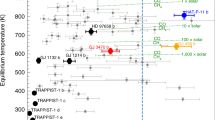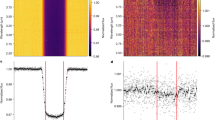Abstract
Observations of transiting gas giant exoplanets have revealed a pervasive depletion of methane1,2,3,4, which has only recently been identified atmospherically5,6. The depletion is thought to be maintained by disequilibrium processes such as photochemistry or mixing from a hotter interior7,8,9. However, the interiors are largely unconstrained along with the vertical mixing strength and only upper limits on the CH4 depletion have been available. The warm Neptune WASP-107 b stands out among exoplanets with an unusually low density, reported low core mass10, and temperatures amenable to CH4 though previous observations have yet to find the molecule2,4. Here we present a JWST NIRSpec transmission spectrum of WASP-107 b which shows features from both SO2 and CH4 along with H2O, CO2, and CO. We detect methane with 4.2σ significance at an abundance of 1.0±0.5 ppm, which is depleted by 3 orders of magnitude relative to equilibrium expectations. Our results are highly constraining for the atmosphere and interior, which indicate the envelope has a super-solar metallicity of 43±8× solar, a hot interior with an intrinsic temperature of Tint=460±40 K, and vigorous vertical mixing which depletes CH4 with a diffusion coefficient of Kzz = 1011.6±0.1 cm2/s. Photochemistry has a negligible effect on the CH4 abundance, but is needed to account for the SO2. We infer a core mass of \({{\boldsymbol{11.5}}}_{-{\boldsymbol{3.6}}}^{+{\boldsymbol{3.0}}}\) M⊕, which is much higher than previous upper limits10, releasing a tension with core-accretion models11.
This is a preview of subscription content, access via your institution
Access options
Access Nature and 54 other Nature Portfolio journals
Get Nature+, our best-value online-access subscription
$29.99 / 30 days
cancel any time
Subscribe to this journal
Receive 51 print issues and online access
$199.00 per year
only $3.90 per issue
Rent or buy this article
Prices vary by article type
from$1.95
to$39.95
Prices may be subject to local taxes which are calculated during checkout
Similar content being viewed by others
Author information
Authors and Affiliations
Corresponding author
Supplementary information
Rights and permissions
About this article
Cite this article
Sing, D.K., Rustamkulov, Z., Thorngren, D.P. et al. A warm Neptune’s methane reveals core mass and vigorous atmospheric mixing. Nature (2024). https://doi.org/10.1038/s41586-024-07395-z
Received:
Accepted:
Published:
DOI: https://doi.org/10.1038/s41586-024-07395-z
Comments
By submitting a comment you agree to abide by our Terms and Community Guidelines. If you find something abusive or that does not comply with our terms or guidelines please flag it as inappropriate.



